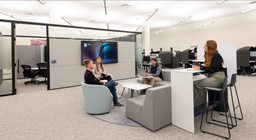It’s Time: Why AVIXA Should Develop the Digital Experience Rating System

In my recent May 21 post, Measuring Success: Why AV Deserves a Rating System, I posed a simple question:
What if AV had a performance-based rating system—like LEED, WELL, or LSRS—that evaluated how people see, hear, share, and collaborate in space?
The Digital Experience Rating System (DXRS) idea has the potential to transform how we design, integrate, and service. It’s more than a checklist or spec template—it’s a proposal to give AV professionals a seat at the design table from the start, not just after the drywall goes up.
We’ve made great strides as an industry with AVIXA audio, video, and control standards. But we still lack a planning framework that clients, architects, IT teams, and facilities managers can understand, adopt, and champion.
That’s the role DXRS is built to fill.
The Gap: AV is Still Too Reactive
Every AV professional has seen it:
- Ceiling plans finalized before speaker or mic placement is considered
- Lighting layouts designed without regard for the camera line of sight
- Hybrid collaboration systems retrofitted, not designed from the start
- Inconsistent usability across campuses or office portfolios
The result? Poor experiences, late-phase change orders, and disappointed users who blame the tech.
It’s not a hardware problem—it’s a planning problem.
The Solution: DXRS as a Performance Planning Framework
The Digital Experience Rating System is structured to evaluate AV-integrated spaces across eight measurable categories:
- Collaboration Support
- AV System Performance
- Environmental Comfort
- Accessibility & Inclusion
- Flexibility & Reconfigurability
- Sustainability & Efficiency
- Feedback & Optimization
- User Experience Quality
Each category has clearly defined, standards-informed sub-criteria. Together, they create a 50-point scoring system to guide design decisions and post-occupancy evaluation.
Why AVIXA Should Lead
AVIXA is the only organization with:
- The credibility to steward a global standard
- The technical foundation to align DXRS with AV performance metrics
- The community reaches to make DXRS collaborative, inclusive, and scalable
By convening a multidisciplinary task force with representatives from AV, architecture, IT, education, healthcare, and the public sector, we could formally develop and pilot DXRS over the next 12–18 months.
What Happens If We Don’t?
Without a framework like DXRS:
- AV remains fragmented, reactive, and inconsistently applied
- Critical design decisions get made without AV input
- We risk becoming "box-droppers" in a world that needs experience designers
The Opportunity Ahead
With DXRS, AV becomes:
- Measurable: Spaces have a score before they're built
- Actionable: Teams have a roadmap for decision-making
- Strategic: AV moves upstream into design and capital planning
This isn’t about prescribing brands—it’s about ensuring that technology and experience are part of the design conversation from day one.
AVIXA, let’s lead this. Let’s make DXRS the next industry-defining standard.
Let’s start the conversation! Add your comments here, connect with me at the AVIXA Xchange Advocates program at 4 pm, Wednesday afternoon (W4761) at InfoComm, or contact me at CatalystFactor.
-
Xchange Advocates are recognized AV/IT industry thought leaders and influencers. We invite you to connect with them and follow their activity across the community as they offer valuable insights and expertise while advocating for and building awareness of the AV industry.
Recommended Content
2026 Preview – What Our Experts Anticipate This Year






Please sign in or register for FREE
If you are a registered user on AVIXA Xchange, please sign in
An exciting idea, although the challenge is going to be in the quantitative determination of the various categories. But I agree that it's necessary!